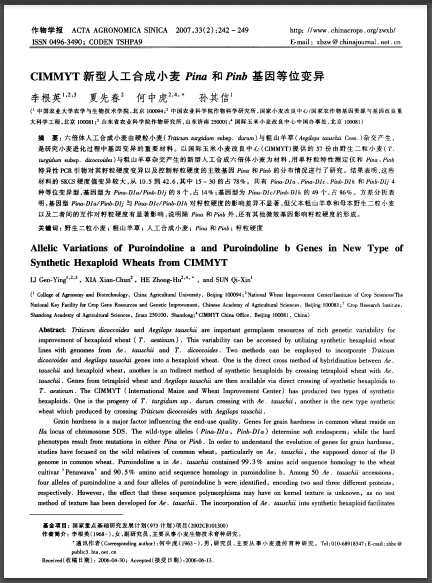Triticum dicoccoides and Aegilops tauschii are important germplasm resources of rich genetic variability for improvement of hexaploid wheat (T. aestivum). This variability can be accessed by utilizing synthetic hexaploid wheat lines with genomes from Ae. tauschii and T. dicoccoides. Two methods can be employed to incorporate Triticum dicoccoides and Aegilops tauschii genes into a hexaploid wheat. One is the direct cross method of hybridization between Ae. tauschii and hexaploid wheat, another is an indirect method of synthetic hexaploids by crossing tetraploid wheat with Ae. tauschii. Genes from tetraploid wheat and Aegilops tauschii are then available via direct crossing of synthetic hexaploids to T. aestivum. The CIMMYT (International Maize and Wheat Improvement Center) has produced two types of synthetic hexaploids. One is the progeny of T. turgidum ssp. durum crossing with Ae. tauschii, another is the new type synthetic wheat which produced by crossing Triticum dicoccoides with Aegilops tauschii. Grain hardness is a major factor influencing the end-use quality. Genes for grain hardness in common wheat reside on Ha locus of chromosome 5DS. The wild-type alleles (Pina-D1a, Pinb-D1a) determine soft endosperm, while the hard phenotypes result from mutations in either Pina or Pinb. In order to understand the evolution of genes for grain hardness, studies have focused on the wild relatives of common wheat, particularly on Ae. tauschii, the supposed donor of the D genome in common wheat. Puroindoline a in Ae. tauschii contained 99.3% amino acid sequence homology to the wheat cultivar ‘Penawawa’ and 90.5% amino acid sequence homology in puroindoline b. Among 50 Ae. tauschii accessions, four alleles of puroindoline a and four alleles of puroindoline b were identified, encoding two and three different proteins, respectively. However, the effect that these sequence polymorphisms may have on kernel texture is unknown, as no test method of texture has been developed for Ae. tauschii. The incorporation of Ae. tauschii into synthetic hexaploid facilitates the analysis of puroindoline sequence polymorphism and other genetic effects on kernel texture, using testing methods designed for hexaploid wheat, such as the Perten single kernel characterization system (SKCS). Analysis of synthetic hexaploid can also facilitate the analysis of the effect of the A and B genomes, contributed by the tetraploid wheat parent on kernel texture. Studies on Ae. tauschii and synthetic hexaploid wheat derived from hybridization of T. turgidum ssp. durum with Ae. tauschii demonstrated a number of novel Pina and Pinb sequences. However, none of these Pina and Pinb mutations produced a hard endosperm texture in synthetic wheat. To further understand the mechanism of grain hardness formation in Ae. tauschii and synthetic wheat, a total of 57 new type synthetic hexaploid lines derived from the crosses T. dicoccoides×Ae.tauschii were employed to evaluate the SKCS hardness and detect puroindoline alleles using gene specific PCR primers. Four allelic variations of Pina and Pinb were identified, i.e., Pina-D1a, Pina-D1c, Pinb-D1h, and Pinb-D1j. Eight lines were Pina-D1a/Pinb-D1j types, accounting for 14%, and 49 were Pina-D1c/Pinb-D1h types, accounting for 86%. Kernel texture differed significantly among the synthetic hexaploid lines, ranging from 10.5 to 42.6, with significant difference among the parental types, T. dicoccoides or Ae. tauschii. The interactions between parental genotypes had also a significant influence on kernel texture. These results indicated that there might be some genes besides Ha locus associated with the kernel texture.

